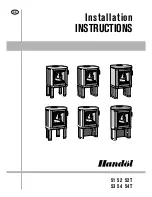
WARNING:
When wood is burnt slowly in a
closed appliance it produces moisture and tar,
which will create condensation and deposits in the
chimney. This effect can be minimised by burning
hard for a short period, about 20 minutes, twice a day.
It is usually convenient to do this morning and night.
Note: To avoid chimney problems your fire should
not be burnt slowly for longer than 12 hours
without a period of fast burning.
WARNING: Properly installed, with a suitable
flue and chimney and operated and maintained
this appliance will not emit fumes into the
dwelling. Occasional fumes from the de-ashing
and re-fuelling may occur. However, persistent
fume emission is potentially dangerous and must
be investigated by a Hetas registered installer.
Stop using the appliance if you smell fumes or
see smoke escaping.
If fume emission does persist, the following
immediate actions should be taken.
• Open doors and windows to ventilate room.
• Let the fire die or extinguish and safely dispose of
fuel from the appliance.
• Check for flue or chimney blockage, and clean if
required.
Seek expert advice from your HETAS registered
installer. Do not attempt to re-light the fire until the
cause of the fume emission has been identified and
corrected.
ASH REMOVAL
Ash will drop through the slots and the sides of the
specially designed grate. This should be removed
from the stove periodically. It is advisable to leave
a layer of ash on the grate to prolong its life and
maintain optimum conditions for burning wood.
DE - ASHING
It is necessary to maintain an ash layer on the upper
surface of the grate, in order to protect it so
de-ashing should cease as soon as the first red
embers drop into the ash pan. Further de-ashing
will cause heat build-up under the grate, which will
considerably shorten its life.
TO EMPTY THE ASH PAN
Open the fire door. Fit the fork end of the operating
tool into the ash pan and remove from the ash
chamber.
WARNING:
The ash can be very hot. Empty only
to a metal container. Even if the ash appears cold,
red-hot pieces of ash may be concealed and could
easily start a fire or cause an injury. Replace the ash
pan and close the fire door.
CLINKER
The formation of clinker suggests that the unit is
being over-fired. Any clinker forming on the grate
should be removed when cold.
OVER-FIRING
Do not
over fire your appliance. Using flammable
liquids or too much wood or firing the fire at
maximum for prolonged periods may result in
over-firing. If the chimney connector or casing
glows red it is being over-fired. If this occurs
immediately close all air inlets to the appliance to
reduce the air supply to the fire.
Should a chimney fire occur immediately close the
appliance down. Get everyone out of the house and
call the fire brigade. A chimney fire may cause
structural damage of the chimney. Do not use the
appliance until the chimney and connector have
been inspected and any damaged parts repaired or
replaced. This should be done by a competent
person such as a HETAS registered engineer.
CLEANING
IMPORTANT
Under some circumstances soot can quickly build
up on the throat plate and adjacent areas. The throat
plate should be removed and checked monthly, and
any debris stripped off. Similarly, clean the upper
surface of the firebox.
Refer to page 15 for instructions on throat plate
removal/inspection.
12
Hamlet Hero Deluxe Multifuel Stove
OPERATING INSTRUCTIONS













































